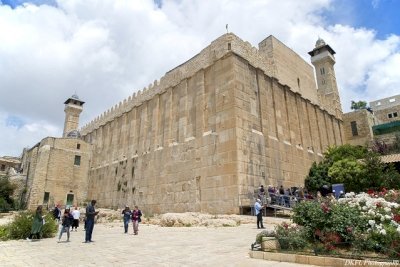
Cave of the Patriarchs
Dating back two thousand years ago, the two-metre thick stone wall which forms the exterior of the Cave is the only fully intact Herodian structure and one of the oldest buildings that still serves its original function. The Byzantine built a roof and turned it into a church; after changing hands from the Muslims to the Crusaders then back to the Muslims, Saladin remodelled the enclosure into a mosque in 1188. The caves, holding the tombs of the patriarchs and their wives, are closed off since the 1490s, forcing pilgrims to project their imaginations onto the respective cenotaphs instead.
For 700 years Jews were forbidden to enter — the closest they could get was up to the seventh step of an outer staircase. Jews began to migrate back to Hebron following the Six-Day War and at long last regained access to the Cave of the Patriarchs, although it continues to be managed by an Islamic charitable trust. Sharing a holy site proved to be anything but smooth, resulting in four attacks targeting Jews from 1968 to 1980, and after a period of calm, a massacre of 29 Palestinians at the hand of a radicalized Brooklyn-born Jew called Baruch Goldstein in 1994. Curfew was imposed on Hebron for two months, disproportionately affecting the Palestinians. Goldstein’s grave has inexplicably become a pilgrimage site for Jewish extremists.
As prevention of further bloodshed the Cave has since been split into two, creating a bizarre scenario where foreigners can access the entire site yet locals are limited to their own spheres the majority of the time — each side gains full control for ten days each year. Is the segregation necessary? The Palestinians are rightfully upset; why should they concede their right to the Cave when they were the victims, but the Israelis point to the fact that no violence has taken place inside the site as proof that this policy is a success.
The Jews have access to the northern section, including the cenotaphs of Jacob and Leah; Abraham’s and Sarah’s lie in two rooms in the middle, visible from both sides; the Ibrahimi mosque contains the remaining two cenotaphs and is the largest of the three sections. Architecturally the 800 year old mosque, with several surviving elements from the 12th-century Crusader church, is much more interesting than the Jewish rooms, which looks like they are hastily assembled.
Hebron Old Town (Palestinian side)
The immediate area surrounding the Cave of the Patriarchs used to be a lively commercial district, yet today it is as dead as an abandoned gold rush town on the West Coast. The IDF (Israeli Defence Force) evacuated the surrounding community after the massacre in 1994, ostensibly as a security measure to prevent retaliation. But judging what has transpired since, it seems more plausible the ultimate aim is to set up a Jewish area that links the Cave of Patriarchs with the Avraham Avinu and Kiryat Arba settlements. Blockades are set up, affecting mostly Palestinians, including school children a few hours ago.
The Israeli side
We continued to explore Avraham Avinu, a settlement right at the heart of Hebron’s historic centre. Approaching the gated community, we come across a deserted square which in a past life was a busy market catered to pilgrims. Now the only thing of note is a plaque commemorating the murder of Shlomo Yitzhak Shapira, who was killed in a terrorist attack in 2002. At the gate of Avraham Avinu is another memorial — a 10-month-old baby named Shalhevet Pass was gunned down by a Palestinian sniper in 2001. More Jews, including a pregnant woman in 2003, were murdered in terrorist acts.
The violence is hardly a one-way street. The father of Shalhevet Pass was arrested for planning to blow up a Palestanian school as retaliation. He was arrested and sentenced to a lenient two-year jail term. Over the years many Palestinian civilians had lost their lives at the hands of the IDF, sometimes by an excessive display of force in ambiguous circumstances. Assaults and harassments of all sorts, committed by both sides, are too numerous to keep count.
More on
Comments
No comments yet.